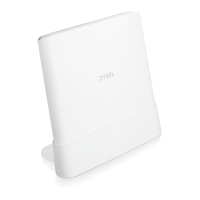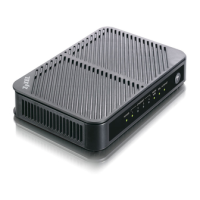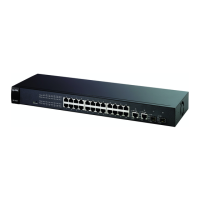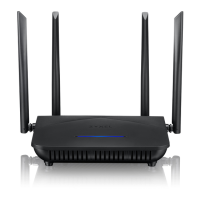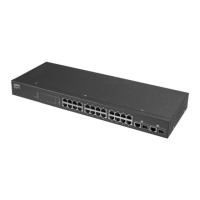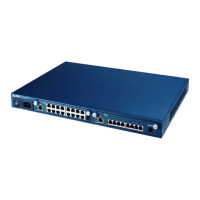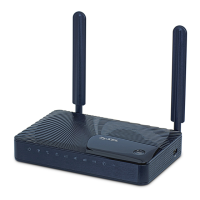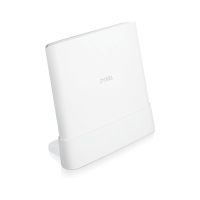
Do you have a question about the ZyXEL Communications AX7501-B0 and is the answer not in the manual?
| Model | AX7501-B0 |
|---|---|
| Manufacturer | ZyXEL Communications |
| Category | Network Router |
| Wireless Standard | Wi-Fi 6 (802.11ax) |
| Wireless Frequency Bands | 2.4 GHz, 5 GHz |
| Security | WPA3 |
| MU-MIMO | Yes |
| OFDMA | Yes |
| USB Ports | 1 x USB 3.0 |
| Security Features | Firewall |
| Ethernet Ports | 5 (1 WAN, 4 LAN) |
Defines how warnings and notes are displayed, including harm to user or device.
Explains syntax conventions like bold font for labels and angle brackets for navigation.
Describes generic icons used in figures, noting the Zyxel Device icon is not an exact representation.
Provides a general overview of the Zyxel Device series and its models.
Illustrates various network environments and applications for the Zyxel Device.
Outlines methods for managing the Zyxel Device: Web Configurator, SNMP, SSH, Telnet, FTP.
Provides recommendations for effective and secure management of the Zyxel Device.
Describes the front and rear panels for each Zyxel Device model.
Details the Zyxel Device LED indicators panel and their behaviors for different models.
Illustrates and describes the ports and buttons on various Zyxel Device models.
Introduces the HTML-based Web Configurator for system setup and management.
Explains the layout of the Web Configurator interface, including icons and panels.
Introduces the Wizard screens for configuring time zone and WiFi settings.
Guides users through the initial setup process for time zone and WiFi networks.
Explains how to select the correct time zone for the Zyxel Device.
Details how the Zyxel Device detects and handles the Internet connection status.
Guides on configuring WiFi Name and Password, including options for dual-band setup.
Confirms that the Zyxel Device saves and applies the configured settings.
Provides an overview of how to use the Zyxel Device's various features via the web interface.
Guides on setting up DSL or Ethernet Internet connections, including Routing and Bridge modes.
Explains how to set up a WiFi network, including security settings and WPS connection.
Covers file sharing, media server functionality, and FTP access via USB devices.
Details configuring Firewall rules, Parental Control, and MAC Filter for network security.
Guides on configuring VoIP settings, SIP accounts, and making phone calls over the Internet.
Explains how to upgrade firmware, backup, and restore device configurations.
Introduces the MPro Mesh app for managing Zyxel Devices and MPro Mesh networks.
Lists the capabilities of the MPro Mesh app, such as deciding the controller and setting up networks.
Explains the MPro Mesh network concept, including Controller and Extender roles.
Guides on setting up MPro Mesh networks with WiFi or wired connections.
Provides steps to check signal icons and find optimal placement for extenders.
Shows how to view the current topology of the MPro Mesh network and device status.
Guides on modifying the default WiFi SSID and password for better security.
Explains how to use Parental Control to limit Internet access based on schedules.
Details how to view connected clients, their link quality, and device details.
Provides steps to change client device names displayed on the MPro Mesh app.
Guides on using the Pause Internet function to block specific clients.
Explains how to set up a Guest WiFi network for different user groups.
Guides on configuring Guest WiFi to allow Internet access only, blocking internal network access.
Describes how to access app online help, version, and privacy policy.
Provides steps to log out of the current Controller device in the MPro Mesh network.
Provides an overview of the Connection Status screen and its features.
Guides on enabling/disabling guest WiFi networks and checking SSIDs/passwords.
Explains how to view LAN IP address, subnet mask, and DHCP settings.
Details how to view parental control profiles and enable parental control.
Discusses Broadband screens for configuring Internet access and WAN interfaces.
Guides on configuring Internet access settings for DSL routers.
Guides on configuring Internet access settings for Ethernet, AON, and PON routers.
Explains how to configure cellular WAN connection as a backup for wired connections.
Details enabling/disabling ADSL over PTM, Annex M, DSL PhyR, and SRA functions.
Explains how to configure the fourth LAN port as an Ethernet WAN port.
Provides additional technical information about Zyxel Device features in this chapter.
Describes Network Setting > Wireless screens for WiFi network and security setup.
Guides on enabling WiFi, entering SSID, and selecting WiFi security mode.
Explains setting up multiple WiFi networks with different security settings.
Details allowing or denying WiFi clients based on MAC addresses.
Guides on configuring WiFi Protected Setup (WPS) for quick and secure WiFi connection.
Explains how to enable WiFi MultiMedia (WMM) for enhanced multimedia performance.
Covers advanced WiFi settings like security, power saving, and data transmission.
Guides on scanning for WiFi channel noise and viewing access point counts.
Explains MPro Mesh support for managing WiFi networks and optimizing bandwidth.
Discusses WiFi in depth, covering terms and concepts related to wireless networking.
Provides an overview of Local Area Network (LAN) and its screens for DHCP and IP management.
Guides on setting the LAN IP address, subnet mask, and DHCP settings.
Explains how to assign fixed IP addresses to LAN clients based on their MAC addresses.
Guides on enabling Universal Plug and Play (UPnP) for network device discovery.
Covers configuring IP alias and public static IP for partitioning the network.
Explains configuring Vendor IDs for Set Top Boxes for static DHCP entries.
Guides on remotely turning on network devices using Wake on LAN (WoL).
Explains identifying a TFTP server for configuration file download using DHCP option 66.
Details Any Port Any Service (APAS) for accessing services from remote WAN devices.
Provides background information on LANs, WANs, DHCP, DNS, and TCP/IP.
Provides a step-by-step guide to enabling UPnP in Windows 10.
Guides on accessing the Web Configurator using UPnP in Windows 10.
Explains how the Zyxel Device uses the default gateway and static routes for traffic.
Guides on viewing and configuring static route rules for LAN devices.
Details configuring DNS routes to forward specific DNS queries to a WAN interface.
Explains how to override default routing by using policy-based routing.
Describes how Routing Information Protocol (RIP) exchanges routing information with other routers.
Explains Quality of Service (QoS) for delivering data with minimum delay and managing bandwidth.
Defines terms and concepts related to QoS, including traffic shaping and policing.
Guides on enabling QoS, setting upstream bandwidth, and assigning traffic priority.
Explains how to configure QoS queue assignment for priority-based traffic forwarding.
Details adding, editing, or deleting QoS classifiers to group traffic flows.
Guides on using token bucket algorithm to limit outgoing traffic rate bursts.
Explains how to limit incoming traffic rate and apply actions like drop or pass.
Shows how to view the Zyxel Device's QoS packet statistics for WAN/LAN interfaces.
Provides technical background on QoS features like IEEE 802.1Q Tag.
Explains NAT as IP address translation for packet routing and defines inside/outside concepts.
Guides on forwarding incoming service requests to servers on the local network.
Details configuring trigger port forwarding for dynamic access to services.
Explains how to configure a default server to receive packets from unspecified ports.
Guides on enabling/disabling Application Layer Gateway (ALG) for specific applications.
Covers mapping local IP addresses to global IP addresses for network access.
Explains how to limit concurrent NAT sessions per client for network performance.
Guides on viewing, adding, or deleting PCP rules for incoming traffic.
Provides technical background on NAT definitions, functionality, and operation.
Explains DNS for mapping domain names to IP addresses and its importance.
Guides on viewing and configuring manual DNS entries on the Zyxel Device.
Explains how to update dynamic IP addresses with hostnames using DDNS services.
Discusses multicast delivery using IGMP/MLD and group settings.
Guides on configuring IGMP/MLD group settings for multicast management.
Explains VLANs for partitioning physical networks into multiple logical networks.
Guides on viewing and managing created VLAN groups on the Zyxel Device.
Discusses creating multiple networks on the Zyxel Device using interface grouping.
Guides on adding LAN interfaces to groups or automatically adding clients via DHCP Vendor ID.
Explains sharing files and accessing media via USB devices connected to the Zyxel Device.
Guides on setting up file sharing and accessing shared folders on USB devices.
Details enabling the media server feature to play files from USB devices on the network.
Explains how to enable the Zyxel Device firewall to protect the network from attacks.
Guides on configuring the security level of the firewall and controlling access.
Details setting the firewall security level and grouping rules by packet direction.
Explains configuring customized services and port numbers for reusable firewall objects.
Guides on creating and configuring incoming or outgoing filtering rules (ACLs).
Details activating protection against Denial of Service (DoS) attacks.
Provides technical background on firewall rules and security enhancement guidelines.
Explains configuring MAC addresses to permit or deny access to wired LAN clients.
Guides on enabling MAC Address Filter and adding host name and MAC address entries.
Introduces URL filtering for blocking user access to specific websites.
Guides on configuring URL filtering settings to block specific websites.
Explains how parental control limits user access and prevents viewing inappropriate content.
Guides on enabling parental control and defining restricted access schedules.
Details enabling parental control, viewing rules, and configuring URL filtering.
Explains how Scheduler Rules define time periods and days for Zyxel Device actions.
Guides on viewing, adding, or editing time schedule rules for features like Firewall.
Explains certificates for user authentication using public-private key pairs.
Defines terms like Certification Authority and Public/Private Keys for certificates.
Guides on viewing, generating requests, and importing signed certificates.
Details viewing a summary list of trusted Certification Authorities (CAs).
Guides on importing CA certificates to the Zyxel Device for trust.
Explains how to view detailed information about a certification authority's certificate.
Provides technical background on certificates, CA, public/private keys, and encryption.
Introduces making calls over the Internet using VoIP and SIP technology.
Advises on prerequisites like having a VoIP account and necessary information ready.
Guides on setting up a SIP account for making outgoing VoIP calls.
Details configuring SIP server information and phone functions for a SIP provider.
Explains configuring SIP TLS settings, local port, and certificates for secure connections.
Guides on configuring SIP numbers and regions for IP phones connected to the Zyxel Device.
Details configuring settings based on the Zyxel Device's region for improved call quality.
Explains how to add, edit, or remove speed-dial numbers for outgoing calls.
Guides on viewing summaries of received, dialed, and missed calls.
Provides background material relevant to the VoIP screens.
Explains how to determine log categories and display system/security logs.
Guides on viewing system logs, filtering by severity level and category.
Details viewing security-related logs by selecting severity level and/or category.
Explains how to view network traffic status and statistics for WAN/LAN interfaces and NAT.
Guides on viewing WAN traffic statistics, including bytes received/sent and packet statistics.
Details viewing packet statistics for each LAN or WLAN interface on the Zyxel Device.
Explains how to view devices that received an IP address and established a session.
Provides information on VoIP registration, current call status, and phone numbers.
Explains Address Resolution Protocol (ARP) for mapping IP to MAC addresses on LAN.
Guides on viewing IPv4-to-MAC and IPv6-to-MAC address mappings.
Explains that routing is based on destination address and shortest path.
Shows IPv4 and IPv6 routing information, including destination, gateway, and subnet mask.
Explains how to view IGMP/MLD group status and traffic statistics.
Guides on configuring IGMP group settings for multicast management.
Details viewing MLD multicast groups managed by the Zyxel Device.
Provides information about DSL statistics, including port details.
Guides on viewing detailed DSL statistics like line rate and SNR margin.
Explains how to view information and status of wireless stations associated with the Zyxel Device.
Guides on looking at cellular Internet connection status and backup configurations.
Details configuring cellular settings when a compatible cellular dongle is inserted.
Explains how to name the Zyxel Device (Host) and associate a domain name.
Guides on assigning a unique name to the Zyxel Device for network recognition.
Provides an overview of user accounts and their privileges for managing the Zyxel Device.
Guides on creating or managing user accounts and their privileges.
Explains remote management controls through interfaces and web services.
Guides on configuring interfaces for remote access and specifying service port numbers.
Details viewing allowed public IP addresses for local management services access.
Explains Simple Network Management Protocol (SNMP) settings on the Zyxel Device.
Guides on configuring SNMP agent, community strings, and system information.
Shows how to configure system-related settings, including system date and time.
Guides on configuring the Zyxel Device's time based on local time zone and server address.
Explains how to send reports, logs, or notifications via email.
Guides on viewing, removing, and adding email account information for notifications.
Explains how to configure where logs are sent and which types of logs are recorded.
Guides on configuring log destination (Syslog server or local file) and log types.
Explains how to upload new firmware releases from a service provider.
Guides on uploading new firmware to the Zyxel Device via HTTP.
Provides information on factory default settings and backup configuration.
Guides on backing up and restoring Zyxel Device configurations.
Explains how to reboot the Zyxel Device remotely without turning off power.
Explains how to use the Diagnostic screen to identify Zyxel Device problems.
Defines terms related to diagnostic tests like CFM, OAM, and loopback tests.
Guides on using ping, traceroute, nslookup, or speed test for troubleshooting.
Details configuring and performing Connectivity Fault Management (CFM) actions.
Explains link layer Ethernet OAM (Operations, Administration and Maintenance) protocol.
Guides on performing OAM F4 or F5 loopback tests on a PVC.
Provides suggestions for solving potential problems categorized by type.
Addresses issues like the Zyxel Device not turning on or LEDs not behaving as expected.
Troubleshoots issues related to knowing the IP address, forgetting passwords, or accessing Web Configurator.
Covers issues like inability to access the Internet via Fiber, Ethernet, or Cellular connections.
Addresses issues with connecting to Zyxel Device WiFi or slow/intermittent WiFi connections.
Troubleshoots issues where the Zyxel Device fails to detect a connected USB device.
Addresses issues with making phone calls through the phone connected to the Zyxel Device.
Troubleshoots issues where a computer cannot detect UPnP settings from the Zyxel Device.
Provides resources for searching support information and troubleshooting suggestions.

